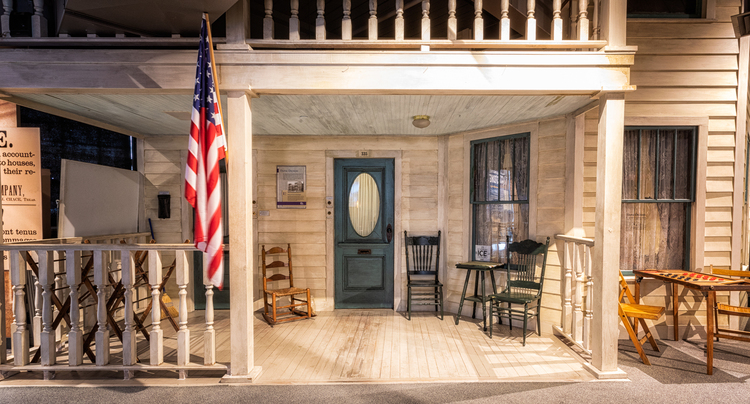
The Triple Decker
A home is more than somewhere to live. A home is where a family creates its memories and, importantly for newcomers, can help reinforce the sense of belonging to a place. When immigrant families arrived in the Blackstone River Valley, they often rented their homes in “mill villages.” Mill owners developed these carefully-planned communities near their factories, complete with amenities like parks, playgrounds, company stores, and even schools and hospitals. In the nineteenth century, for example, mill owner Edward Harris built the Privilege Mill complex in Woonsocket near the North Main Street area, featuring a brick mill, 18 brick tenements, a three-level store, and a dam on the river that formed Harris Pond. Many owners like Harris believed it was part of their duty to extend decent housing to their workers.
However, these arrangements gave mill owners control over almost every aspect of their workers’ lives. Sometimes mill owners paid their employees in ‘scrip’, a type of currency which could only be redeemed at company-owned stores. For working-class families, renting or owning a home outside of mill villages represented independence away from the company gaze, as well as establishment in their new country. To this end, many working families in Woonsocket sought out three-story houses, called “triple deckers.”
This exhibit in the Museum recreates part of the exterior of a typical triple decker. In the early twentieth century, these homes were the most common residential structures built in Woonsocket. Built of inexpensive wood and designed to be narrow and deep, most triple deckers had three separate one-floor apartments; at this point in time, it was not uncommon for multiple generations of the same family to occupy two or all floors of the house, which was similar to how large French-Canadian farm families had lived in Québec. Housing grandparents, parents, and children in the same structure meant that there was a continual source of childcare (grandparents who couldn’t work watching the children who were too young to work) and elder care, allowing both parents to work shifts at the mills.
The front porches of Woonsocket’s triple deckers also resembled the porches of French-Canadian farm houses, providing another reminder of the homes these families had left behind. For people who spent all of their working day indoors in the mills, the outdoor space of the porch was a pleasant respite. Workers used these spaces to enjoy the open air, to chat with neighbors across porches, and to play traditional music. Some houses had side or back porches, in addition to front porches.
The front porch was also an important spot for chores and daily life. Families would hang their laundry to dry on wooden racks on the porch (generally the back porch. They also had clotheslines) and would receive their daily deliveries of milk and ice from local merchants here as well.
The interior of this exhibit, in contrast, is actually not the kind of home you would expect a recent immigrant to have. The fine furnishings here – the elegant furniture, the rug, the piano – are more reminiscent of a factory foreman or manager’s parlor, or entertaining room.
This room is also a journey through time: it contains three ways to play music from different decades that would not all have been displayed together at the same time. The piano was for people to play familiar songs or make their own music, often with the help of sheet music. The record player nearby allowed listeners to enjoy music without having to play it: they would listen to music on record albums. Lastly, the radio in this room represented another shift in how people would listen to music: the radio station programmers would pick what was broadcast, and everyone who listened to a certain station would all be united by listening to the same thing, whether it was music or news. The popularity of the radio played an important role in Americanization of successive generations of French-Canadian immigrants, because it gave them exposure to experiences and ways of life beyond their towns.
This room also contains the handle of an old-fashioned phone, which was on a “party line” shared among multiple families in the same triple-decker building. In order to use the phone, residents would have to either wait until the phone was not in use or get on the line and ask the person already on the phone to hang up.
-
Introduction
-
The Farmhouse
-
Flowing Through Time
-
The Church
-
Transition
-
Mill Floor
-
The Treasury of Life
-
Stairwell
-
Baseball
-
The Triple Decker
-
The Mills Along the Blackstone
-
The Classroom
-
Woonsocket Industrialists
-
The ITU Hall
-
The Merci Boxcar
-
Introduction Alt Text
-
The Farmhouse Alt Text
-
Flowing Through Time Alt Text
-
The Church Alt Text
-
Transition Alt Text
-
Mill Floor Alt Text
-
The Treasury of Life Alt Text
-
Stairwell Alt Text
-
Baseball Alt Text
-
The Triple Decker Alt Text
-
The Mills Along the Blackstone Alt Text
-
The Classroom Alt Text
-
Woonsocket Industrialists Alt Text
-
The ITU Hall Alt Text
-
The Merci Boxcar Alt Text